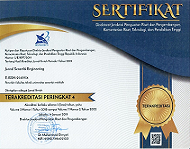Sistem Moving Bed Biofilm Reactor Menggunakan Mikroalga dalam Menyisihkan Amonia (NH3-N) dan Fosfat (PO4) Pada Air Limbah Tahu
Keywords:
MBBR, microalga nannochloropsis oculata, bioball, sponge (biocube), tofu waste waterAbstract
The tofu industry produces wastewater containing high levels of ammonia (NH3-N) and phosphate (PO4). High levels of pollutants cause water pollution when tofu wastewater is discharged directly into the environment. An alternative biological treatment to overcome this problem is to use the microalgae Nannochloropsis oculata suspended and attached to form a biofilm in the Moving Bed Biofilm Reactor (MBBR). This research aims to determine the effect of variations in media, media volume and sampling time on the reduction of NH3-N and PO4 levels in tofu wastewater using the MBBR system with the microalgae Nannochloropsis oculata continuously. The MBBR reactor was operated with different sponge media of 20%, 30% and 40%; bioball media of 20%, 30% and 40%; and sampling time variations of 0, 4, 8, 12 hours (after 24 hours HRT). The research results showed that variations in the type of sponge media, with a media volume of 20% of the wastewater volume, were best at degrading ammonia and phosphate in tofu wastewater with an operating time of 12 hours. The highest percentage of ammonia and phosphate removal achieved in a 20% sponge media at the 12th hour of sampling was 90.83% and 72.45% with parameter values of 0.43 ????????/???? and 7.5 ????????/???? respectively
















